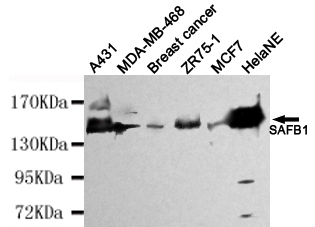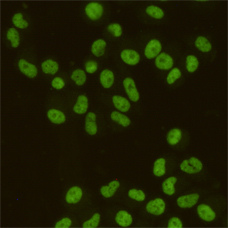- Home
- About
- Promotions
-
Products
-
Elisa Kits
- |
-
Primary antibodies
- |
-
Secondary antibodies
- |
-
Proteins
- |
-
IHC reagents
- |
-
WB reagents
- PonceauS Staining Solution
- PBST Washing Buffer, 10X
- 1.5M Tris-HCl Buffer, pH8.8
- 1M Tris-HCl Buffer, pH6.8
- 10% SDS Solution
- Prestained Protein Marker
- TBST Washing Buffer, 10X
- SDS PAGE Loading Buffer, 5X
- Stripping Buffered Solution
- Tris Buffer, pH7.4, 10X
- Total Protein Extraction Kit
- Running Buffer, 10X
- Transfer Buffer, 10X
- 30% Acr-Bis(29:1) Solution
- Tris电泳液速溶颗粒
- PBS(1X, premixed powder)
- TBS(1X, premixed powder)
- 快速封闭液
- 转膜液速溶颗粒
- Chemical reagents
- News
- Distributor
- Resources
- Contact
- Home
- >
- Info
- >
- SAFB1 mouse mAb
- >
- Go Back
SAFB1 mouse mAb
- Catalog No.:YM1300
- Applications:WB;ICC
- Reactivity:Human
- Immunogen:
- Purified recombinant human SAFB1 protein fragments expressed in E.coli.
- Specificity:
- This antibody detects endogenous levels of SAFB1 and does not cross-react with related prote
- Formulation:
- Liquid in PBS containing 50% glycerol, 0.5% BSA and 0.02% sodium azide.
- Source:
- Monoclonal, Mouse
- Dilution:
- wb 1:1000 icc 1:200
- Purification:
- The antibody was affinity-purified from mouse ascites by affinity-chromatography using epitope-specific immunogen.
- Storage Stability:
- -15°C to -25°C/1 year(Do not lower than -25°C)
- Other Name:
- DKFZp779C1727;glutathione S transferase fusion protein;HAP;HET;HSP27 ERE TATA binding protein;HSP27 ERE-TATA-binding protein;HSP27 estrogen response element-TATA box-binding protein;SAF B;SAF-B1;SAFB 1;SAFB;SAFB1;SAFB1_HUMAN;scaffold attachment factor B1.
- Background:
- This gene encodes a DNA-binding protein which has high specificity for scaffold or matrix attachment region DNA elements (S/MAR DNA). This protein is thought to be involved in attaching the base of chromatin loops to the nuclear matrix but there is conflicting evidence as to whether this protein is a component of chromatin or a nuclear matrix protein. Scaffold attachment factors are a specific subset of nuclear matrix proteins (NMP) that specifically bind to S/MAR. The encoded protein is thought to serve as a molecular base to assemble a 'transcriptosome complex' in the vicinity of actively transcribed genes. It is involved in the regulation of heat shock protein 27 transcription, can act as an estrogen receptor co-repressor and is a candidate for breast tumorigenesis. This gene is arranged head-to-head with a similar gene whose product has the same functions. Multiple transcript v
- Function:
- function:Binds to scaffold/matrix attachment region (S/MAR) DNA and forms a molecular assembly point to allow the formation of a 'transcriptosomal' complex (consisting of SR proteins and RNA polymerase II) coupling transcription and RNA processing (By similarity). Can function as an estrogen receptor corepressor and can also bind to the HSP27 promoter and decrease its transcription. Can inhibit cell proliferation.,similarity:Contains 1 RRM (RNA recognition motif) domain.,similarity:Contains 1 SAP domain.,subunit:Monomer. Can form homodimers. Interacts with KHDRBS3, POLR2A, SAFB2 or SFRS1, SFRS9 and TRA2B/SFRS10.,tissue specificity:Ubiquitous. Expressed at high levels in the CNS and at low levels in the liver. Expressed in a wide number of breast cancer cell lines.,
- Subcellular Location:
- Nucleus .
- Expression:
- Ubiquitous. Expressed at high levels in the CNS and at low levels in the liver. Expressed in a wide number of breast cancer cell lines.

- Western blot detection of SAFB1 in HelaNE,A431,MDA-MB-468,Breast cancer,ZR75-1 and MCF7 cell lysates using SAFB1 mouse mAb (1:4000 diluted).Predicted band size: 130kDa.Observed band size: 130kDa.

- Immunocytochemistry staining of HeLa cells fixed with 4% Paraformaldehyde and using SAFB1 mouse mAb (dilution 1:200).




